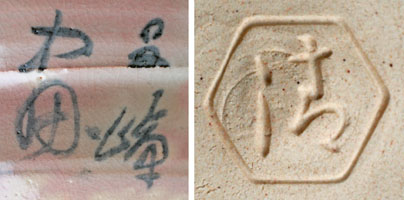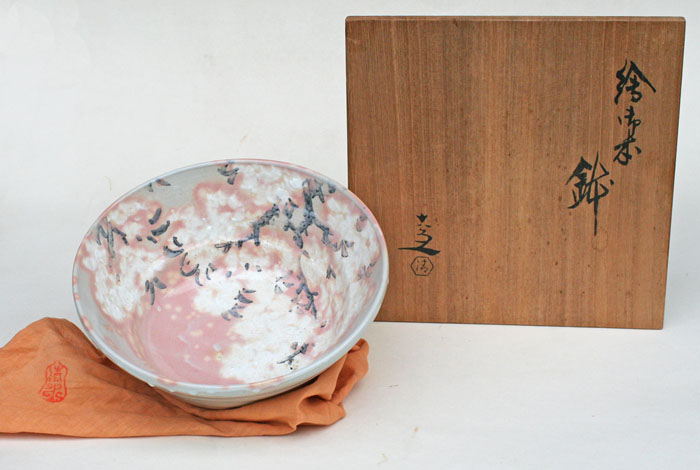Kyôyaki
Kashibachi, cake bowl - Sakura, Cherry blossomSigned: Suishô ga
Seals: Kiyo
Technique: grey pink gohonde kyôyaki with an underglaze painting of cherry blossom Ø 23.5 x 9.6
Box: signed by Rokubei
Condition: fine
Suishô was born in Fushimi, Kyoto, where in 1893 he entered the school of Takeuchi Seihô (1864-1942. From the following year, Suishô won prizes at various exhibitions and expositions, and at a young age became a prominent student of Seihô, along with fellow students Nishimura Goun (1877-1938) and Hashimoto Kansetsu (1883-1945). Suishô later became Seiho's son-in-law. To prolongue his stdies he went to the Kyoto Municipal School of Arts and Crafts.
In 1907, he exhibited at the first Bunten exhibition and won the third prize, which was followed by many more prizes and special awards. When in 1919 the Teiten was established, he was selected as a juror based on his past achievements, but also exhibited many of his own works. In 1929 he was recommended for membership of the Imperial Academy of Fine Arts.
In 1929 he was recommended for membership of the Imperial Academy of Fine Arts, and in 1937, when the Teiten was reorganised, he became a member of the Imperial Academy of Fine Arts and a judge for the New Bunten Exhibition. After Seiho's death in 1942, he was appointed as a member of the Imperial Household Artists' Association, and was respected as an elder statesman in the world of Japanese painting. After the end of the
war, when he was in his seventies, Suisho continued to work.
Reference:
Berry ‘99. pp. 246-248 (# 70)
Aburai p. 289
Roberts p. 120
Rokubei V (Shôrei) (1875-1959) was the second son of Kiyomizu Rokubei IV.
Rokubei V studied Shijô painting with Kôno Bairei (1844-1895). Kikuchi Hôbun (1862-1918), Taniguchi Kôkyô (1864-1915), Takeuchi Seihô (1864-1942) and Tsuji Kakô (1870-1931) were his classmates. He also studied at the Kyoto Prefectural School of Painting, and studied ceramic techniques with his father after graduation. His career as a ceramic artist began when he won a prize at the Fourth Domestic Industrial Exposition in 1895. He studied glazing techniques at the Kyoto Municipal Ceramic Laboratory established in 1896 and organized the Promoting Society for Craft Workers (Shokkô Shôrei-kai) with designer Kikuchi Sokû at the Laboratory in 1899. He actively worked on the study and research of new glazing techniques and (Western) designs. When Rokubei IV retired, he inherited the title and became Rokubei V in 1913. He exhibited at the Nôten, the Design and Applied Artworks Exhibition sponsored by the Ministry of Agriculture and Commerce and the Teiten, the Imperial Art Academy Exhibition. He also became a member of the Imperial Art Academy and played an important role as a leading figure of the craft world. In 1945 he retired and took the artist’s name Rokuwa.
Reference:
Kyoto ‘03, ’Sekka’ p. 326 ff.
Price: ON REQUEST

